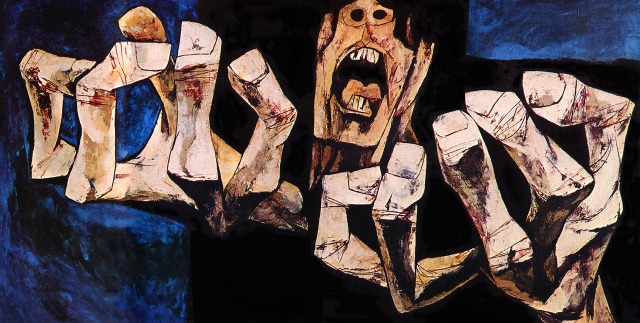Oil Painting, Ecuador 1968
Las Manos de la Protesta, Hands of Protest, belongs to the collection “Hands” from Guayasamin’s Edad de la Ira, Age of Wrath, gallery. La Edad de la Ira series was developed between 1961 and 1990, comprising of 150 large-scale paintings. Within that series are collections that explore the same topic, such as “Hands” (12 oils), “Weeping Women” (7 oils), “the Waiting” (11 oils), “the Mutilated” (6 oils), “Meeting at the Pentagon” (5 oils), and “Rivers of Blood” (3 oils). All of these collections report on the violence of man versus man in the 20th century. Guayasamin explores the expressive potential of faces, hands and bodies to convey a range of human sentiments captured with his oil on canvas.
The La Edad de la Ira series specifically addresses human suffering caused by war, genocide, torture, poverty and discrimination that could be felt on a global scale. In Las Manos de la Protesta, Guayasamin showcases raw human emotion through expressive color and gesture. Guayasamin focused on expressing the theme of the universal human suffering. Coarse and skeletal, hands are made huge and exaggerated, confronting the viewer and dominating the canvas. The impetus behind Guayasamin’s conception of La Edad de la Ira, is the denunciation of human suffering, echoed by the social ideology of the Indigenist movement.
Las Manos de la Protesta is a piece that is both beautiful and very difficult to look at. To do so is to stare into the souls of the marginalized, dispossessed, and wretched of the Earth. It is to stare into the chaos that we pretend does not exist. The most eye-catching element is the intimidating size of Guayasamin’s work, in this case 244 x 122 cm. There is a feeling of heaviness about the protagonists, despite their skeletal aspect and interlaced postures. The yellowish color, frequently used by the artist, conveys a massy atmosphere which contrasts very well with the embossed faces and the blue color. If we look long enough, we feel, if for a moment, that we can no longer ignore it and continue on with our lives of blissful ignorance.
The suffering portrayed in Las Manos de la Protesta, can also be analyzed within the political context of Ecuador in the 1960s. The atmosphere in Ecuador was very violent and revolved around demands of political rights due to protests and mobilization. From 1912-1999, Ecuador lacked political stability due to social and economic problems that had been carried over from the time of post-colonization. This painting represents aggravation towards the society. The creature’s mouth is opened up widely which indicates that he is screaming in chaos. It is a statement against the corrupt government full of wealthy merchants and bankers. The distorted creature’s hands are very big begging for a resolution to end all the protests and sufferings.
Guayasamin’s work evokes strong emotional responses, dealing with the horrors of war, the injustices of inequality and discrimination, and the rights of women, children, and indigenous peoples. Growing up, Guayasamin experienced poverty, loss, political unrest, and racial discrimination as the son of an indigenous father and Mestiza mother. After graduating from the School of Fine Arts in Quito for painting and sculpting, his talent allowed him to travel all over the world. The injustices he witnessed on his travels became the subject of his life’s work. He is the winner of biennials in Barcelona and São Paulo, recipient of France’s Legion of Honor, and recognized by UNESCO with its José Martí Prize. Guayasamin was a personal friend of leading intellectuals and statesmen of the progressive world, and has portrayed some of them, like Fidel and Raul Castro, Francois and Danielle Mitterrand, Gabriel García Márquez, Rigoberta Menchú, among others
In addition to his constant desire to denounce poverty, starvation, violence and torture in this world, Guayasamin also wishes to express his ideals and dreams, in bringing together suffering with patience and hope. In 1971, he was elected president of Ecuador’s House of Culture and in 1976 he created the Guayasamin Foundation in Quito, to which he offered his works and collection. It is in the Guayasamin Foundation where one can find Las Manos de la Protesta. The Guayasamin Foundation is the cultural instrument (private non-profit organization) responsible for the promotion and enhancement of the work and thought of Guayasamin. It is accessible to all people as Guayasamin considered art a universal heritage, and hence dedicated his entire life to art in order to express his struggle against injustice. As Rigoberta Menchú stated: “He was a man of Latin American conviction and a fighter for democracy. His work reflects his deep commitment to social progress and to people who have been ignored and exploited…His memory will stay with us and will be a permanent encouragement for those who seek a better future for humanity.”
Sources:
Bucknell University. “Of Rage and Redemption: The Art of Oswaldo Guayasamín.” N.p. 16 April. Web. http://www.bucknell.edu/x47603.xml
Burn With Books. “The Hands by Guayasamín.” N.p. 16 April. Web. http://burnwithbooks.com/2012/03/07/the-hands-by-guayasamin/#
Capilla del Hombre. “Fundacion Guayasamin.” N.p. 16 April. Web. http://www.capilladelhombre.com/
EcuRed. “Oswaldo Guayasamín.” N.p. 16 April. Web. http://www.ecured.cu/index.php/Oswaldo_Guayasam%C3%ADn
Guayasamin. “Biografía.” N.p. 16 April. Web. http://www.guayasamin.org/index.php?option=com_content&view=article&id=71&Itemid=290
In- Quito. “Quito Oswaldo Guayasamin.” N.p. 16 April. Web. http://www.in-quito.com/guayasamin-quito-ecuador/quito-oswaldo-guayasamin.htm
The UNESCO Works Of Art Collection. “Guayasamin, Oswaldo (1919-1999).” N.p. 16 April. Web. http://www.unesco.org/artcollection/NavigationAction.do?idOeuvre=1574
University of Miami Digital Collections. “Oswaldo Guayasamín: An Art that Transcends Time.” N.p. 16 April. Web. http://scholar.library.miami.edu/1492books/OswaldoGuayasamin.pdf
Vanderbilt Fine Arts Gallery. “Edad De La Ira (Age of Wrath).” N.p. 16 April. Web. http://www.vanderbilt.edu/gallery/guayasamin/wrath.html

